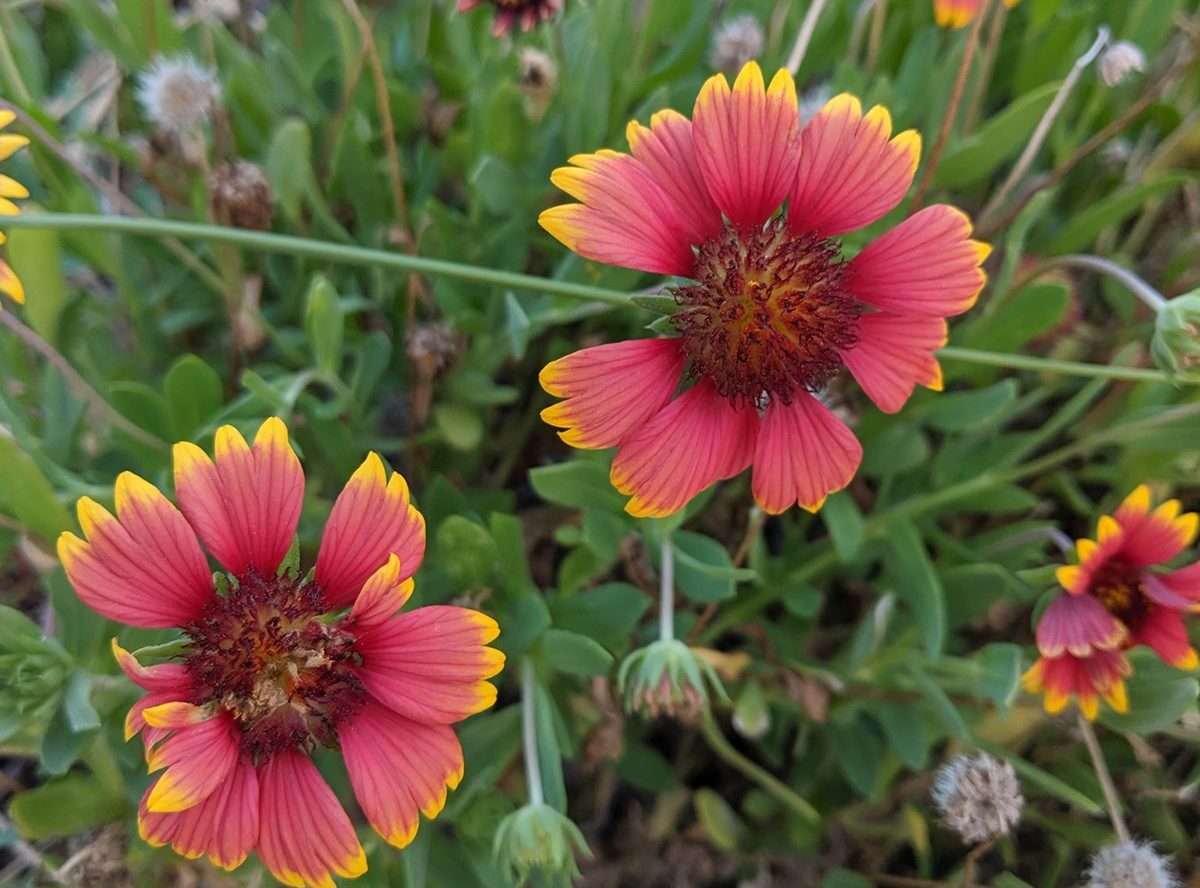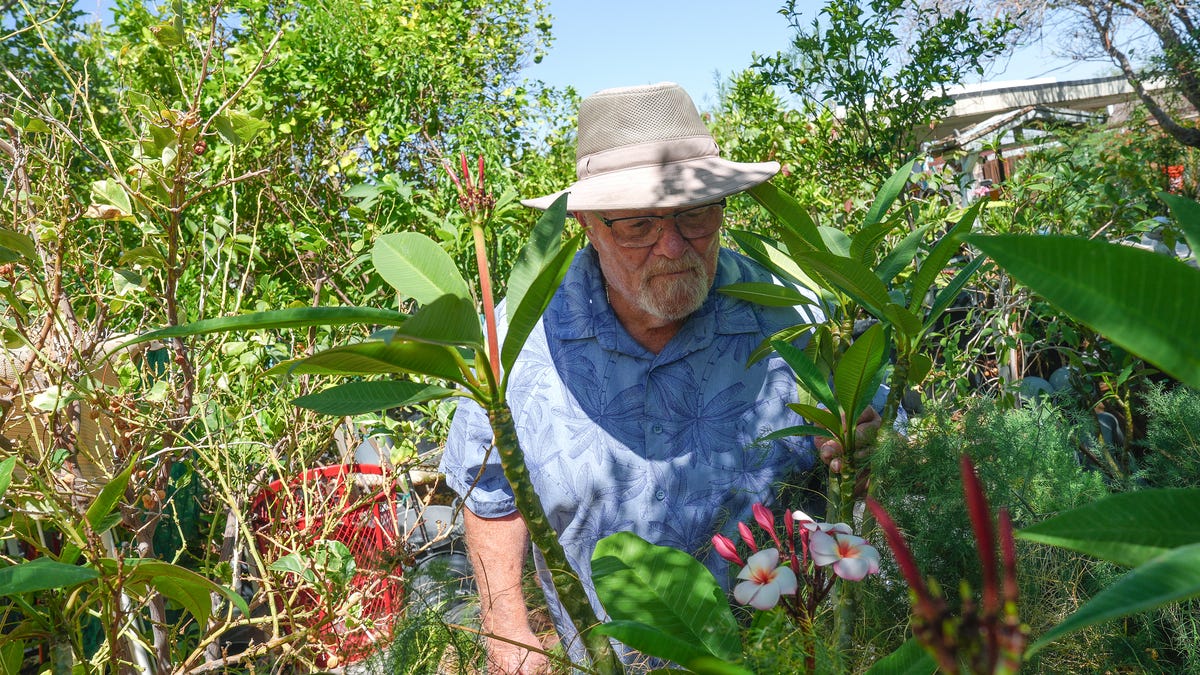Many annuals and perennials need plenty of sunlight to thrive. Whether you have sunny areas in your front, side, or backyard or a porch, patio, or balcony and want to add more plants that will come back year after year, there are plenty of sun loving perennials to choose from. Many full-sun perennials provide important food sources for bees, butterflies, birds, bats, and moths. While you’re enjoying the colorful hues and curious and cool looking blossoms, you’ll also get a pollinator show with their frequent visits.
Southern Living Plant Collection
American Beautyberry
Want a plant that has white flowers before producing stunning purple-hued round berries? Plant American Beautyberry. “Small clusters of white flowers bloom in the late spring and early summer and the bright berries encircle the stems from August through October,” says Nicole Dillon, micro-flower farmer and owner of Breemar Flower Farm based in Ashland, Virginia. The berries are an important food source for many bird species, especially in the colder months when there is less available. “The fruit(s) will remain on the stems through winter and are a valuable food source for birds and small mammals,” she says. As long as you grow them in a sunny area, these hardy plants will grow well in most types of soil so long as it drains well.
- Botanical Name: Callicarpa americana
- Sun Exposure: Full sun, partial
- Soil Type: Moist, well-drained, loamy, clay
- Soil pH: Acidic, neutral (5.0-7.0)
Bee Balm
If you want to grow natives well-suited to the South, Bee Balm or Oswego Tea is a wonderful choice. “Known for its vibrant red, tubular flowers arranged in dense clusters atop sturdy stems, it attracts pollinators like hummingbirds, bees, and butterflies throughout the summer months,” says Laura Root, a horticulturist for Jackson & Perkins. This herb can manage in a variety of soil conditions and is drought-tolerant, too, after it’s established. “Monarda didyma thrives in sunny garden beds and provides both ornamental beauty and ecological benefits as a native plant species,” she says.
- Botanical Name: Monarda spp.
- Sun Exposure: Partial, full sun
- Soil Type: Moist, well-drained, tolerates clay
- Soil pH: Neutral, acidic
Black-eyed Susan
Getty Images / dolah
Native plants are important to grow for biodiversity and for creating habitat and food sources for wildlife, such as birds, bees and butterflies. “Black-eyed Susans are hardy, easy to grow, and excellent for attracting pollinators,” says Root. “It produces cheerful yellow flowers with dark centers that bloom from summer to fall.”
Black-eyed Susan does well in Southern climates and can survive in hot weather. “Rudbeckia is drought-tolerant once established, tolerating high temperatures and requiring minimal morning watering,” says Root.
- Botanical Name: Rudbeckia hirta
- Sun Exposure: Partial, full sun
- Soil Type: Clay, loamy, sandy, well-drained
- Soil pH: Acidic, neutral, alkaline
Blanket Flower
Southern Living Plant Collection, Janet Sluis
With flowers that look like daisies in hues of orange, red, or yellow, blanket flowers are easy and fun to grow. “Gaillardia is a champion of extended flowering in sunny spaces,” says Linda Vater, a plant expert for the Southern Living® Plant Collection. Drought-tolerant plants once they are established, this is good news if you’re a plant parent that often forgets to water. Vater recommends the nativar—created to be pest and disease resistant—REALFLOR® Sunset ‘Celebration’ Gaillardia for its bright red flowers that you’ll enjoy from spring to fall.
- Botanical Name: Gaillardia x grandiflora
- Sun Exposure: Full
- Soil Type: Well-drained
- Soil pH: Slightly acid
Blazing Star
Getty Images / Sharon Dominick
These stunning beauties are a favorite of many pollinators. “They all send out tall flower spikes, usually purple, that are irresistible to native bees, butterflies, and hummingbirds,” says Dillon. They love and need full sun to thrive. “I made the mistake of placing them in a north-facing bed that gets quite a bit of shade during the day,” she says. “They still grow and flower normally, but are prone to flopping, thus requiring support.”
- Botanical Name: Liatris spicata
- Sun Exposure: Full
- Soil Type: Clay, loamy, sandy
- Soil pH: Acidic, neutral
Cardinal Flower
Getty Images
Consider the Cardinal flower if one of your goals is to plant more native plants in your landscape. “Cardinal flowers send up tall red spikes that when planted in mass, attract hummingbirds and butterflies with their sweet nectar,” says Dillon. “This plant is native to almost all of the United States (with the exception of the Northwest) meaning it should thrive when given the right conditions,” explains Dillon.
These need moist, wet areas and thrive in areas where many plants wouldn’t fare well. “Lobelia grows wild around the ponds in my neighborhood and thrives in those low-lying, moist areas of the garden that can sometimes be troublesome to get something to grow,” she says. They make a great plant for a rain garden.
- Botanical Name: Lobelia cardinalis
- Sun Exposure: Full, partial
- Soil Type: Moist, well-drained
- Soil pH: Acidic to neutral
Eastern Blue Star
Looking to add more flowers to your garden space to attract pollinators? “Eastern Blue Star (Amsonia tabernaemontana) bursts full of baby blue star-like clusters that appear as large flowers in spring,” says Dillon. “Then in fall, the foliage transitions to a beautiful golden color.” This can grow in a variety of conditions and is drought-tolerant, so if you forget to water your plants or live in a drier area, this is a good option.
- Botanical Name: Amsonia tabernaemontana
- Sun Exposure: Full sun, part shade
- Soil Type: Sandy, loamy, moist
- Soil pH: Neutral
Hardy Hibiscus
If you’re wanting to add a stunning tropical flower that grows well in containers, raised beds, or directly in the ground, grow hardy hibiscus. Dillon says it’s her favorite full-sun perennial to grow, and neighbors frequently ask her about this flower. “I grow ‘Midnight Marvel’ hibiscus paired with ‘Cheyenne Sky’ Red Switchgrass, and Ginger Wine NineBark, all of which are perennial,” says Dillon. Be patient for it to bloom, which is typically around the start of summer. “Hardy hibiscus are some of the last plants to break dormancy, so make sure you give it time to do so,” she says. “Because of its indeterminate bud nodes along the stems, this plant continues to flower from June through the first frost.”
- Botanical Name: Hibiscus spp.
- Sun Exposure: Full
- Soil Type: Well-draining, organic
- Soil pH: Slightly acidic to alkaline (6.0-8.0)
Honeysuckle
Want to have more hummingbirds and pollinators in your garden? Plant honeysuckle for its vibrant blooms. “Honeysuckle is a native vine that performs well in full sun and is ideal for trellises or fences,” says Root. Another advantage of honeysuckle is that it’s easy to grow and can handle some neglect. “This perennial is drought-tolerant, low-maintenance, mildew-free, and provides a beautiful vertical element to the garden,” she adds. She recommends the variety Major Wheeler.
Root advises that you pay attention to the honeysuckle botanical name before purchasing, as there are invasive honeysuckle. “This variety should not be confused with the invasive species, Lonicera japonica, seen in the wild,” she says.
- Botanical Name: Lonicera sp.
- Sun Exposure: Full sun
- Soil Type: Moist, well-drained, rich
- Soil pH: Acidic to alkaline 5.5-8.0
Lantana
Lantana have striking pom-pom style blooms made up of smaller flowers that can look like mini suction cups. “Lantana is a beautiful, floriferous summer perennial [and] is loaded with blooms all summer and brings the tropics to your backyard with its blended orange, hot pink, and yellow petals,” says Dillon. Hummingbirds love these flowers, so grow them if you want to attract them to your yard. These grow well in zones 7-11. “If you’re in the lower zones, give them a thick mulch layer for extra protection during the winter,” Dillon adds.
- Botanical Name: Lantana spp.
- Sun Exposure: Full
- Soil Type: Well-drained
- Soil pH: Acidic, neutral
Miss Lemon™ Abelia
Southern Living Plant Collection, Kathleen Schmucker
Abelia is a shrub that produces small flowers and is often found in gardens in the South. Miss Lemon™ Abelia is a staple in my sunny landscape for its eye-catching combination of stunning variegated foliage, charming, delicate blooms, and low-maintenance nature,” says Vater. Versatile plants, these can be grown in an array of landscapes and garden styles. “Its compact size makes it suitable for various garden designs as a foundation planting, low border, or as a container specimen on a sunny patio,” she says.
- Botanical Name: Abelia x grandiflora
- Sun Exposure: Full, partial
- Soil Type: Well-draining, moist
- Soil pH: 5.0-7.5
Sedum
Southern Living/Adrienne Legault
Sedums are part of the succulent family, so they can handle the heat and fare well in hot climates. “Sedum comes in a wide array of shapes, colors, and sizes,” says Dillon. There are numerous varieties of sedum [that] range from groundcovers where the foliage is more prized than the flowers to tall plants. “‘Lemon Coral’ Sedum is a wonderful chartreuse ground cover that when placed next to a walkway seems to illuminate the path and draw you into the rest of the garden,” says Dillon. Some varieties produce blooms later in the year. “‘Autumn Joy’ and ‘Carl’ are more shrub-like sedums known for their autumn blooms,” she says.
- Botanical Name: Sedum spp.
- Sun Exposure: Full
- Soil Type: Sandy, well-draining
- Soil pH: 6.0-7.5
‘Stellar Ruby’ Magnolia
Southern Living Plant Collection
Want to incorporate more flowers to your landscape that aren’t as common? “A lesser-known yet prized variety of magnolia for Southern gardeners is ‘Stellar Ruby’ Magnolia,” says Vater. These begin to bloom at the end of spring and throughout the summer and fall. “Breathtaking pink to ruby-hued, banana-scented blooms contrast dense evergreen foliage that requires minimal pruning,” she adds.
- Botanical Name: Magnolia figo Hybrid ‘Stellar Ruby’
- Sun Exposure: Full, partial
- Soil Type: Well-draining, moist
- Soil pH: Slightly acidic (6.0-6.5)
Torch Lily
“Kniphofia, commonly known as ‘red hot poker’ or ‘torch lily,’ is prized for its striking, torch-like flower spikes in shades of red, orange, and yellow,” shares Root. This is a favorite among hummingbirds, who enjoy the blooms in late spring through the summer months. Deer typically leave this plant alone, so you don’t have to worry about them munching on it.
These plants are low-maintenance and can grow in most types of soil, as long as it’s well-draining. Plant throughout garden beds or as a border. “Its architectural foliage and wildlife attracting flowers add both visual interest and ecological value to garden landscapes,” says Root.
- Botanical Name: Kniphofia
- Sun Exposure: Full sun
- Soil Type: Average, well-draining
- Soil pH: 6 to 7.5







:max_bytes(150000):strip_icc()/IMG_64301-1b8cbaf3b155401fa231655985a01c44.jpg)

